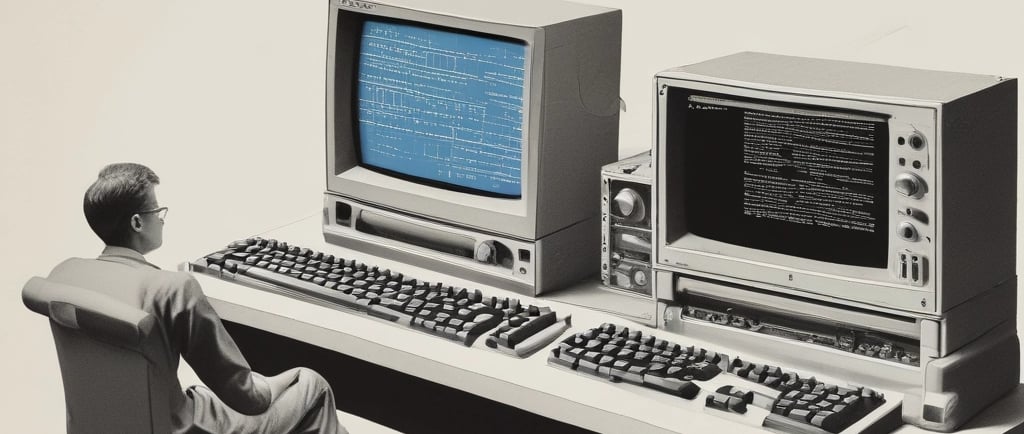The Silent Revolution of 64-Bit Computers
Elina Mark


Think about the last time you worried about your computer running out of memory while opening too many browser tabs, or whether a new piece of software would work on your machine. If you're under a certain age, you probably haven't. This everyday convenience is a direct gift from one of the most important, yet understated, transitions in computing history: the shift from 32-bit to 64-bit computing.
This wasn't just an incremental speed boost. It was a fundamental architectural leap that reshaped the boundaries of what our personal devices are capable of.
The Core Difference: It's All About the Address Book
Imagine a computer's memory (RAM) as a massive city, and the CPU is a taxi driver needing to deliver data to specific addresses. The "bitness" of the CPU determines the size of the address book it can use.
A 32-bit CPU has an address book with enough room for about 4.3 billion addresses (2^32). This translates to a maximum of 4GB of RAM it can theoretically access. In practice, it was often less, as some address space was reserved for other hardware.
A 64-bit CPU has an astronomically larger address book. It can access 18 quintillion addresses (2^64). This is over 18 billion GBs of RAM.
This isn't just a bigger number; it's a difference in kind. The 4GB limit of 32-bit computing was a brick wall that the industry was rapidly approaching in the early 2000s. High-end PCs, professional workstations, and servers were starving for more memory to handle complex tasks, and the 64-bit architecture was the only way forward.
Why This Leap Was a Game-Changer
The benefits of moving to 64-bit went far beyond just being able to install more RAM.
1. Breaking the RAM Ceiling:
This was the most immediate and critical advantage. With 64-bit, applications are no longer constrained. Whether it's a massive Excel spreadsheet, a complex engineering simulation, editing a 4K video file, or having 50 tabs open in Chrome, the system can keep all that data readily accessible in RAM. This eliminates constant, sluggish hard drive swapping and keeps everything running smoothly.
2. A Boost in Precision and Performance:
A 64-bit processor can handle data in larger, 64-bit chunks. For certain types of calculations, especially in scientific computing, financial modeling, and advanced graphics, this means it can process more data per clock cycle and handle numbers with far greater precision and speed. While not every application sees a direct doubling in speed, the overall efficiency of the system is dramatically improved.
3. Enhanced Security:
The transition to 64-bit allowed for the implementation of more robust hardware-level security features. Technologies like Data Execution Prevention (DEP) became more effective, making it significantly harder for malware to exploit vulnerabilities in the system.
The Invisible Ubiquity: You're Already Living in a 64-bit World
Unless you're running a very old machine, every device you've used in the last decade is almost certainly 64-bit.
Your Laptop/Desktop: Any modern Windows (x64), macOS, or Linux computer is running on a 64-bit CPU and a 64-bit operating system.
Your Smartphone: Both Apple's A-series chips (since the iPhone 5s) and Android processors (ARM64) are 64-bit architectures. This is a key reason why mobile devices can now handle tasks that would have required a desktop computer years ago.
Gaming Consoles: The PlayStation 5 and Xbox Series X/S are 64-bit powerhouses, leveraging the architecture to stream vast, detailed game worlds seamlessly.
The software ecosystem has fully embraced this shift. Today, when you download an application, you are almost always getting its 64-bit version. Major operating systems like macOS have completely dropped support for 32-bit apps, and Windows is steadily moving in that direction.
Is 32-bit Completely Obsolete?
For all practical purposes, yes, for new systems. You cannot buy a new consumer computer with a 32-bit processor. However, 32-bit computing lives on in the world of embedded systems—the tiny computers inside appliances, industrial machinery, and some legacy equipment where the simplicity and low power requirements of a 32-bit chip are still sufficient.
The Bottom Line
The transition to 64-bit computing was not as flashy as the introduction of the GPU or the SSD, but it was arguably more fundamental. It was an upgrade to the very foundation of computing, tearing down the walls that were holding back progress. It empowered the software we take for granted today, from complex creative suites and immersive games to sophisticated operating systems.
The 64-bit computer is the silent, robust engine of the modern digital world. We don't often think about it, but its immense capacity is the reason our technology feels so limitless, powerful, and responsive.